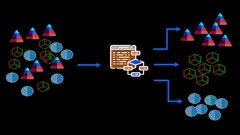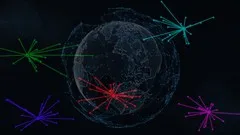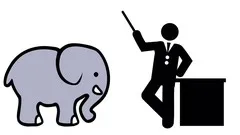
Cluster Analysis : Unsupervised Machine Learning in Python 
Discover the power of unsupervised machine learning with the Cluster Analysis course in Python. Dive into the world of artificial intelligence and machine learning as you learn how to analyze and cluster unlabeled datasets. Uncover hidden patterns and data groupings without human intervention. Explore popular clustering techniques such as K-Means, Hierarchical, and Mean Shift Clustering. Compare different models using performance metrics and build machine learning models to make clusters using your own data. With a booming job market and high earning potential, this course is your ticket to a successful career in machine learning. Don't miss out, start your learning journey today! Get a comprehesive understanding of Cluster Analysis : Unsupervised Machine Learning in Python which is a pay course. AZ Class provides this course data for free. Learn more certificate and details here. ▼
ADVERTISEMENT
Course Feature
![]() Cost:
Cost:
Paid
![]() Provider:
Provider:
Udemy
![]() Certificate:
Certificate:
Paid Certification
![]() Language:
Language:
English
![]() Start Date:
Start Date:
2022-08-02
Course Overview
❗The content presented here is sourced directly from Udemy platform. For comprehensive course details, including enrollment information, simply click on the 'Go to class' link on our website.
Updated in [October 16th, 2023]
What does this course tell?
(Please note that the following overview content is from the original platform)
Artificial intelligence and machine learning are touching our everyday lives in more-and-more ways. There’s an endless supply of industries and applications that machine learning can make more efficient and intelligent. You have probably come across Google News, which automatically groups similar news articles under a topic. Have you ever wondered what process runs in the background to arrive at these groups? Unsupervised machine learning is the underlying method behind a large part of this. Unsupervised machine learning algorithms analyze and cluster unlabeled datasets. These algorithms discover hidden patterns or data groupings without human intervention. This course introduces you to one of the prominent modelling families of Unsupervised Machine Learning called Clustering. This course provides the learners with the foundational knowledge to use Clustering models to create insights. You will become familiar with the most successful and widely used Clustering techniques, such as:K-Means ClusteringHierarchical ClusteringMean Shift ClusteringDBSCAN : Density-Based Spatial Clustering of Applications with NoiseOPTICS : Ordering points to identify the clustering structureSpectral ClusteringYou will learn how to train clustering models to cluster and use performance metrics to compare different models. By the end of this course, you will be able to build machine learning models to make clusters using your data. The complete Python programs and datasets included in the class are also available for download. This course is designed most straightforwardly to utilize your time wisely. Get ready to do more learning than your machine!Happy Learning.Career Growth:Employment website Indeed has listed machine learning engineers as #1 among The Best Jobs in the U.S., citing a 344% growth rate and a median salary of $146,085 per year. Overall, computer and information technology jobs are booming, with employment projected to grow 11% from 2019 to 2029.
We considered the value of this course from many aspects, and finally summarized it for you from two aspects: skills and knowledge, and the people who benefit from it:
(Please note that our content is optimized through artificial intelligence tools and carefully reviewed by our editorial staff.)
What skills and knowledge will you acquire during this course?
During this course on Cluster Analysis: Unsupervised Machine Learning in Python, learners will acquire the following skills and knowledge:
1. Understanding of unsupervised machine learning: Learners will gain a foundational understanding of unsupervised machine learning algorithms and their applications in analyzing and clustering unlabeled datasets.
2. Familiarity with clustering techniques: Learners will become familiar with various clustering techniques, including K-Means Clustering, Hierarchical Clustering, Mean Shift Clustering, DBSCAN, OPTICS, and Spectral Clustering. They will learn how to apply these techniques to discover hidden patterns and groupings in data.
3. Training clustering models: Learners will learn how to train clustering models using Python. They will understand the process of building machine learning models to create clusters based on their data.
4. Performance evaluation: Learners will gain knowledge on how to use performance metrics to compare different clustering models. They will learn how to assess the effectiveness and accuracy of their models.
5. Practical implementation: The course provides complete Python programs and datasets that learners can download and use for hands-on practice. They will have the opportunity to apply the concepts learned in the course to real-world scenarios.
By the end of the course, learners will have the skills and knowledge to build machine learning models for clustering data using Python. This course is designed to optimize learning time and provide a straightforward approach to mastering cluster analysis.
Additionally, acquiring skills in machine learning, specifically in the field of clustering, can contribute to career growth. Machine learning engineers are in high demand, with a projected growth rate of 344% and a median salary of $146,085 per year. The overall employment outlook for computer and information technology jobs is also promising, with an expected growth rate of 11% from 2019 to 2029.
Who will benefit from this course?
This course on Cluster Analysis: Unsupervised Machine Learning in Python will benefit individuals interested in or working in the field of artificial intelligence and machine learning. Specifically, the following professionals will find value in this course:
1. Data Scientists: Data scientists who want to enhance their skills in unsupervised machine learning and clustering techniques will benefit from this course. They will learn how to analyze and cluster unlabeled datasets, discover hidden patterns, and create insights using clustering models.
2. Machine Learning Engineers: Machine learning engineers, who are responsible for developing and deploying machine learning models, will find this course valuable. They will learn various clustering techniques, such as K-Means, Hierarchical, Mean Shift, DBSCAN, OPTICS, and Spectral Clustering, and how to train clustering models to make clusters using their data.
3. AI Researchers: Researchers in the field of artificial intelligence who are interested in exploring unsupervised machine learning methods and clustering algorithms will gain knowledge and insights from this course. They will learn about the underlying methods behind clustering and how to apply them to their research.
4. Data Analysts: Data analysts who want to expand their skill set and learn how to uncover hidden patterns and groupings in datasets will benefit from this course. They will gain knowledge of different clustering techniques and how to use performance metrics to compare and evaluate clustering models.
5. IT Professionals: IT professionals looking to upskill and stay relevant in the rapidly growing field of artificial intelligence and machine learning will find this course beneficial. They will learn practical skills in unsupervised machine learning and clustering, which are in high demand in the job market.
Course Syllabus
Introduction
Building and Evaluating Clustering ML Models
Course Provider

Provider Udemy's Stats at AZClass
Discussion and Reviews
0.0 (Based on 0 reviews)
Explore Similar Online Courses

Master Cluster Analysis 2023

Unsupervised Machine Learning: Cluster Analysis Algorithms

Python for Informatics: Exploring Information

Social Network Analysis

Introduction to Systematic Review and Meta-Analysis

The Analytics Edge

DCO042 - Python For Informatics

Causal Diagrams: Draw Your Assumptions Before Your Conclusions

Whole genome sequencing of bacterial genomes - tools and applications

Hadoop Cluster Administration Course: Guide for Hadoop Admin

Cluster Analysis and Unsupervised Machine Learning in Python


Start your review of Cluster Analysis : Unsupervised Machine Learning in Python